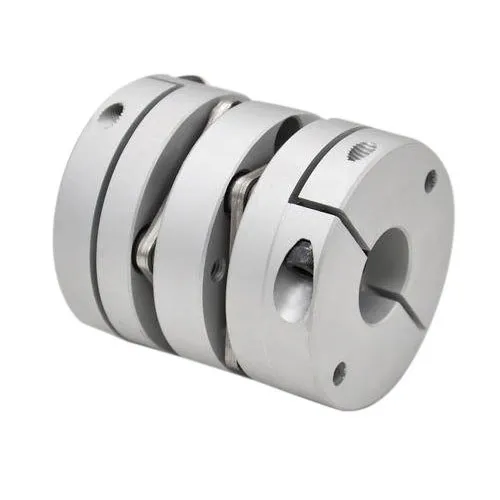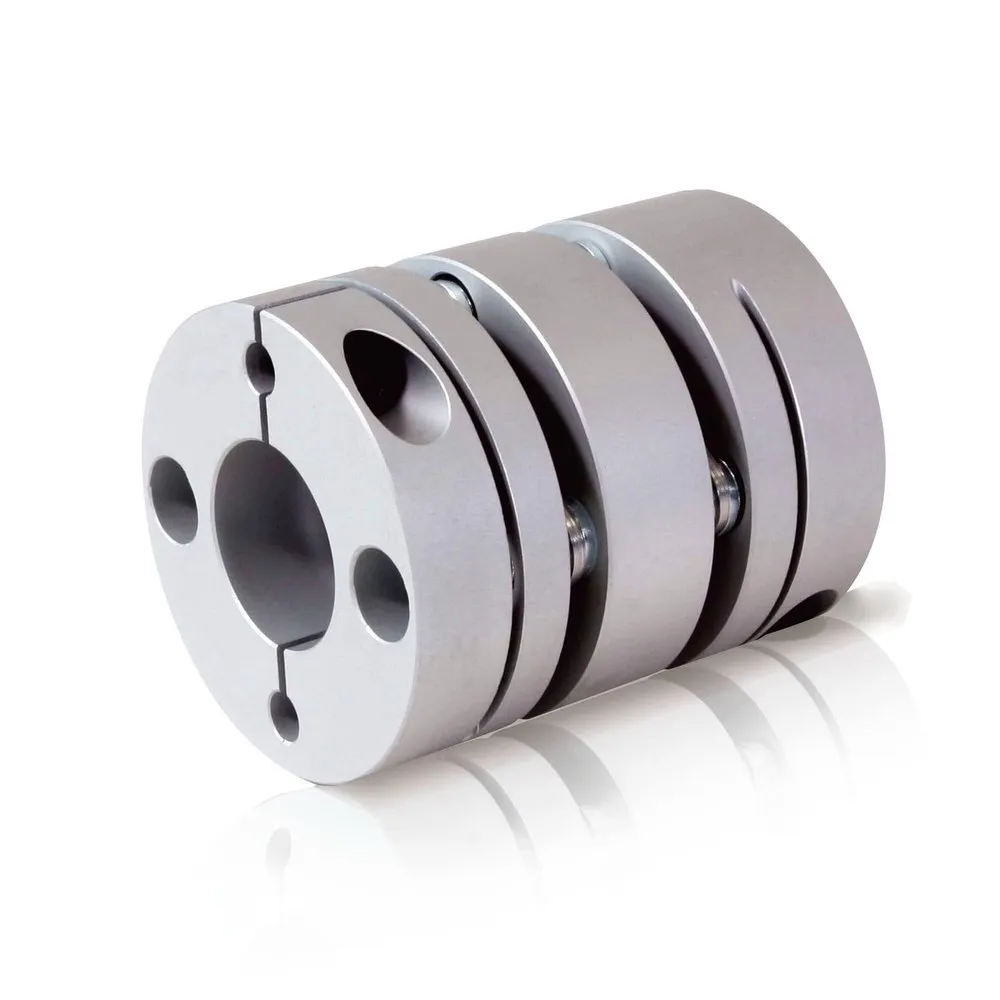Product Description
The Manufacturer Supplies Coupling Rigid Screw Coupling Clamping Shell Double Diaphragm Servo Motor Aluminum Alloy Diaphragm Coupling
Detailed Photos
| brand | ever power |
| country of origin | china |
Application
Application of Aluminum Alloy Diaphragm Coupling
-
Machinery and Automation: Diaphragm couplings are used in various machinery and automation systems, such as CNC machines, robotic arms, printing presses, packaging equipment, and conveyor systems. These couplings provide accurate torque transmission, compensate for misalignment, and dampen vibrations, ensuring smooth and efficient operation.
-
Power Generation: Aluminum alloy diaphragm couplings are employed in power generation equipment, including generators, turbines, and pumps. They efficiently transmit torque between the driving and driven components while accommodating misalignment and torsional vibrations.
-
Aerospace and Aviation: Diaphragm couplings are utilized in aerospace and aviation applications, such as aircraft engines and auxiliary power units (APUs). Due to their lightweight construction and high torsional stiffness, aluminum alloy diaphragm couplings help reduce weight and ensure precise torque transmission in critical aerospace systems.
-
Oil and Gas Industry: Diaphragm couplings are commonly used in oil and gas exploration and production equipment, such as pumps, compressors, and drilling rigs. They provide reliable torque transmission, compensate for misalignment, and withstand harsh operating conditions in these demanding environments.
-
Motorsports: Aluminum alloy diaphragm couplings find applications in motorsports, particularly in high-performance racing cars and motorcycles. These couplings help transmit torque from the engine to the drivetrain while maintaining precision and handling the demands of high-speed and high-power applications.
-
Marine Industry: Diaphragm couplings are utilized in various marine applications, including propulsion systems, marine generators, and marine pumps. They provide efficient torque transfer and compensate for misalignment and shaft deflection, ensuring reliable performance in marine environments.
/* March 10, 2571 17:59:20 */!function(){function s(e,r){var a,o={};try{e&&e.split(“,”).forEach(function(e,t){e&&(a=e.match(/(.*?):(.*)$/))&&1

Thermal Considerations and Limits for Continuous Operations with Servo Couplings
Servo couplings, like many mechanical components, can experience temperature changes during continuous operation. It is essential to consider thermal factors and establish temperature limits to ensure the proper functioning and longevity of the couplings. Here are the key thermal considerations and limits:
- Temperature Ratings:
Manufacturers provide temperature ratings for servo couplings, indicating the range of temperatures in which the couplings can operate safely. It is crucial to stay within these specified temperature limits to prevent potential damage to the coupling or its connected components.
- Heat Dissipation:
Servo couplings may generate heat during operation due to friction and torsional loads. The ability of the coupling to dissipate heat effectively helps prevent excessive temperature rise. Choosing a coupling with suitable materials and design can improve heat dissipation.
- Continuous vs. Intermittent Operation:
Servo couplings may have different thermal limits for continuous operation compared to intermittent or start-stop operations. It is essential to ensure that the coupling’s temperature ratings are suitable for the application’s specific mode of operation.
- Environment:
The operating environment can also impact the thermal performance of the servo coupling. High ambient temperatures, confined spaces, or inadequate ventilation can elevate the temperature around the coupling, potentially pushing it beyond its limits.
- Lubrication:
Proper lubrication of the coupling’s components can help reduce friction and heat generation. Using the right lubricant and ensuring regular maintenance can contribute to the coupling’s optimal thermal performance.
- Thermal Expansion:
Thermal expansion of materials can lead to dimensional changes in the coupling. If not accounted for, this expansion can cause misalignment or interference with other components. Understanding the thermal expansion properties of the coupling materials is crucial for precise system design.
- Overheating Prevention:
To prevent overheating, monitoring the coupling’s temperature during continuous operations is advisable. Implementing temperature sensors or thermal monitoring systems can help detect abnormal temperature increases and trigger appropriate actions, such as reducing operating speeds or shutting down the system temporarily.
- Material Selection:
Choosing materials with appropriate thermal properties is vital for withstanding continuous operations. Some materials are more resistant to high temperatures and thermal cycling, making them suitable for applications with demanding thermal conditions.
By considering these thermal considerations and adhering to the specified temperature limits, users can ensure that servo couplings operate reliably and efficiently during continuous operations, avoiding potential failures and ensuring the longevity of the motion control system.

How Servo Couplings Help in Reducing Vibrations and Resonance during Operation
Servo couplings play a crucial role in reducing vibrations and resonance during the operation of motion control systems. Here’s how they achieve this:
- Damping Properties: Some servo couplings, especially those made from materials with high damping properties, can absorb and dissipate vibrations. These couplings act as shock absorbers, reducing the impact of sudden changes in motion and minimizing vibrations in the system.
- Flexibility: Flexible servo couplings have the ability to compensate for misalignments between the motor and the driven load. This flexibility helps distribute the load evenly, preventing excessive forces that may lead to resonance. By accommodating misalignments, flexible couplings also reduce stress on the motor and bearings, minimizing vibrations.
- Vibration Isolation: Some servo couplings, such as elastomeric couplings, have inherent vibration isolation properties. The elastomeric material acts as a cushion, isolating the motor and driven load from external vibrations and disturbances that could affect system performance.
- Reduced Backlash: Zero-backlash couplings eliminate play between coupling components, preventing sudden changes in motion direction. This reduction in backlash reduces the chances of vibrations caused by rapid acceleration or deceleration and ensures smooth and stable motion.
- Dynamic Balancing: Certain servo couplings are precisely balanced during the manufacturing process. This dynamic balancing helps counteract any rotational imbalance in the system, reducing vibrations caused by uneven distribution of mass.
- Torsional Stiffness: Servo couplings with appropriate torsional stiffness prevent excessive twisting or deflection during operation. This stiffness maintains the stability of the system and minimizes vibrations.
By effectively reducing vibrations and resonance, servo couplings contribute to the overall performance and reliability of motion control systems. The selection of the right coupling type, taking into consideration the specific requirements of the application, is essential to ensure optimal vibration damping and smooth operation.

Finding Reputable Suppliers or Manufacturers of Servo Couplings for Specific Automation Needs
When looking for high-quality servo couplings to meet your specific automation needs, it’s essential to find reputable suppliers or manufacturers. Here are some methods and resources to help you in your search:
- 1. Online Search Engines:
Use popular search engines like Google or Bing to find suppliers and manufacturers of servo couplings. Try using specific keywords related to your automation needs, such as “high-torque servo couplings” or “precision motion control couplings.”
- 2. Industry Directories:
Check industry directories and databases that list suppliers and manufacturers of motion control components. Websites like Thomasnet, GlobalSpec, and Alibaba can be helpful in finding reputable companies.
- 3. Trade Shows and Conferences:
Attend industry-specific trade shows, exhibitions, and conferences related to automation and motion control. These events often feature numerous suppliers and manufacturers showcasing their products, giving you a chance to interact directly with them.
- 4. Motion Control Associations:
Explore websites and directories of motion control associations or societies. They often have lists of member companies that are reputable and adhere to industry standards.
- 5. Online Marketplaces:
Visit online marketplaces like Amazon, eBay, or specialized platforms for industrial equipment. While using these platforms, it’s crucial to verify the seller’s reputation and read customer reviews.
- 6. Industry Forums and Communities:
Participate in online forums or communities related to automation and motion control. Here, you can seek recommendations from experienced professionals or inquire about their experiences with specific suppliers or manufacturers.
- 7. Recommendations:
Ask for recommendations from colleagues, peers, or industry experts who have experience in automation and have worked with servo couplings. Their insights can lead you to reliable suppliers.
- 8. Supplier Websites:
Visit the websites of potential suppliers or manufacturers. Look for information about their product offerings, certifications, manufacturing processes, and customer reviews or testimonials.
- 9. Request for Quotations:
Contact multiple suppliers and request quotations based on your specific requirements. Compare the offerings, technical support, and pricing before making a decision.
- 10. Technical Support and Customization:
Consider suppliers or manufacturers who offer technical support and the option for customization to ensure that the servo couplings meet your precise automation needs.
Remember to assess the supplier’s reputation, product quality, certifications, and customer service before making a purchase. Taking the time to research and choose a reputable supplier will help ensure that you receive high-quality servo couplings that meet your specific automation requirements.


editor by CX 2024-02-13
